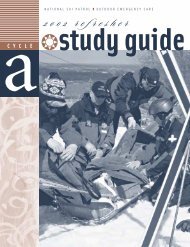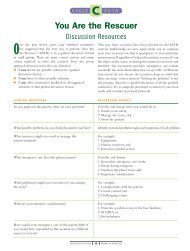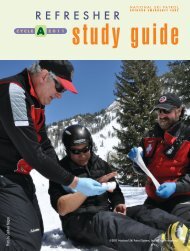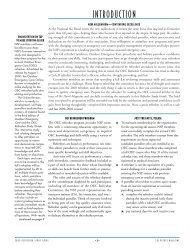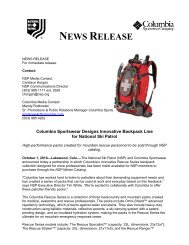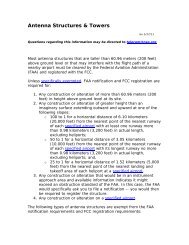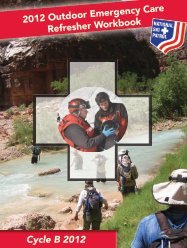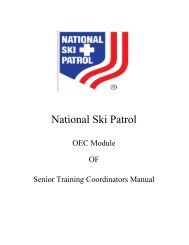You Are the Rescuer Scenario I - National Ski Patrol
You Are the Rescuer Scenario I - National Ski Patrol
You Are the Rescuer Scenario I - National Ski Patrol
You also want an ePaper? Increase the reach of your titles
YUMPU automatically turns print PDFs into web optimized ePapers that Google loves.
<strong>You</strong> <strong>Are</strong> <strong>the</strong> <strong>Rescuer</strong><br />
The next several pages contain scenarios that place you as <strong>the</strong> first OEC technician<br />
responding to <strong>the</strong> scene of an injury or illness. These scenarios are presented for your<br />
consideration and discussion. There are many “right” answers and appropriate solutions.<br />
Regardless of where <strong>the</strong> incident actually occurred—on a ski slope, in a river, or on a<br />
hiking trail—<strong>the</strong> assessment and basic emergency care remain essentially <strong>the</strong> same.<br />
Carefully read <strong>the</strong>se scenarios, each of which is based on an actual incident. Formulate<br />
your emergency care actions based on local area protocols.<br />
To prepare yourself for <strong>the</strong> portion of <strong>the</strong> refresher that features guided discussion about<br />
<strong>the</strong>se scenarios, jot down answers for <strong>the</strong> questions below as well as any notes that pertain<br />
to <strong>the</strong> discussion points and o<strong>the</strong>r thoughts that come to mind as you consider each scenario.<br />
Use additional paper as necessary and be sure to bring <strong>the</strong>se answers and notes to <strong>the</strong><br />
refresher.<br />
<strong>Scenario</strong> I<br />
It’s early in <strong>the</strong> season and <strong>the</strong> snow-making guns are running at full capacity. <strong>You</strong>’re<br />
summoned by radio to respond to an incident halfway down <strong>the</strong> face of a nearby intermediate<br />
slope. Upon arriving on <strong>the</strong> scene you find a young male snowboarder lying prone, with his<br />
head pointing downhill, his face in <strong>the</strong> snow and turned slightly to <strong>the</strong> left, and both arms down<br />
by his sides.<br />
He speaks with hesitation when answering your initial assessment questions, and<br />
complains of a burning sensation in his hands and a complete lack of sensation in his feet.<br />
He is oriented to time and place and denies losing consciousness.<br />
A quick history obtained from a witness reveals that <strong>the</strong> rider was attempting to jump a<br />
snow berm around a snowgun that was marked with bamboo poles, appeared to lose<br />
control, and catapulted 15 feet into <strong>the</strong> air. The witness reports that from an inverted<br />
position <strong>the</strong> snowboarder landed down <strong>the</strong> hill on <strong>the</strong> right side of his head and back right<br />
shoulder. He <strong>the</strong>n slid and tumbled into <strong>the</strong> position in which you found him.<br />
<strong>You</strong>r initial assessment (with <strong>the</strong> patient still prone) reveals palpable cervical muscle<br />
spasm and point tenderness in <strong>the</strong> mid portion of <strong>the</strong> cervical spine. The boarder has no<br />
sensation to firm touch in his arms and hands or in his thighs and legs, and he has no<br />
recognition of when you tap his boots. He is unable to move his arms or legs at all, and<br />
seems frustrated upon discovering this. There are no o<strong>the</strong>r obvious injuries.<br />
Initial pulse is 72 and strong; respirations are 20 and shallow. <strong>You</strong> and fellow patrollers<br />
immobilize <strong>the</strong> young man with a C-collar and backboard, and transport him down <strong>the</strong> hill<br />
in a toboggan to a waiting ambulance. A follow-up assessment conducted when <strong>the</strong> patient<br />
is placed in <strong>the</strong> ambulance reveals some return of sensation to touch on his chest and
anterior left thigh, and a flicker of hand grasp bilaterally. He still reports a burning<br />
sensation in both palms, but still has no apparent motor activity or sensation in his feet.<br />
QUESTIONS<br />
1. What injury/injuries do you suspect in this scenario<br />
2. Do <strong>the</strong> assessment findings described in this scenario enable you to predict long-term<br />
outcomes for this patient Why or why not<br />
3. Describe, in <strong>the</strong> order of priority, <strong>the</strong> emergency care you would provide for this patient.<br />
(Discussion points: emergency care, personnel, equipment, transport.)<br />
NOTES<br />
POINTS TO PONDER<br />
The acute occurrence of a complete spinal cord transection produces a catastrophic<br />
outcome. The physical, emotional, and financial consequences of this permanent<br />
neurological condition can be overwhelming to <strong>the</strong> patient and his or her family. This is<br />
because <strong>the</strong> patient experiences complete motor paralysis and complete anes<strong>the</strong>sia below<br />
<strong>the</strong> level of <strong>the</strong> spinal injury. If <strong>the</strong> injury is in <strong>the</strong> cervical region, <strong>the</strong> loss is obviously<br />
devastating. Spinal shock usually accompanies complete spinal cord transection, and is<br />
recognized by <strong>the</strong> presence of acute hypo<strong>the</strong>rmia, lowered blood pressure, and <strong>the</strong> absence of a<br />
compensatory pulse increase.<br />
Each year in <strong>the</strong> United States approximately 11,000 people suffer a spinal cord injury<br />
(SCI), and of that number roughly 2,000 involve complete cord transactions in <strong>the</strong> cervical<br />
area. Reports estimate that 8.9 percent of all spinal cord injuries occur during sports or<br />
recreation activities. The lifetime medical care and living cost estimates for a 25-year-old<br />
with a low quadriplegia (C5–C8) are estimated at $1.6 million. That figure does not include<br />
indirect costs such as loss of productivity, which, depending on <strong>the</strong> patient’s educational<br />
background, could amount to between $500,000 and $2,000,000. 1<br />
The presence of quadriparesis (partial motor paralysis in all four limbs) and incomplete<br />
loss of sensation distal to <strong>the</strong> affected spinal level establishes <strong>the</strong> possibility that, with<br />
aggressive medical treatment, <strong>the</strong> patient may in time experience some partial functional<br />
neurological recovery. Frequently <strong>the</strong> compressive forces causing <strong>the</strong> spinal injury produce<br />
stellate fractures of <strong>the</strong> vertebral body or, when <strong>the</strong>re are associated bending forces, vertebral<br />
body fractures with retropulsion of bone fragments back into <strong>the</strong> cord.<br />
Both of <strong>the</strong>se events may cause direct compression of <strong>the</strong> spinal cord by bone<br />
fragments, but do not necessarily produce complete cord transection. Prompt surgical<br />
decompression of <strong>the</strong> injury site—along with heavy doses of steroids to reduce cord<br />
swelling—may stimulate partial long-term functional recovery. The possibility that an<br />
incomplete injury to <strong>the</strong> spinal cord might have occurred compels you as OEC provider to
employ <strong>the</strong> utmost skill and caution as you offer emergency care for <strong>the</strong>se patients.<br />
1 Spinal Cord Injury Information Injury Network, “Facts and Figures at a Glance – June, 2006.” Available at<br />
http://www.spinalcord.uab.edu/show.aspdurki=21446. Accessed February 19, 2006.<br />
VITAL VOCABULARY<br />
cervical muscle spasm Involuntary contraction of <strong>the</strong> muscles adjacent to <strong>the</strong> cervical<br />
spine, frequently produced by injury.<br />
complete spinal cord transection Total severance of <strong>the</strong> spinal cord; usually traumatic.<br />
neurogenic shock Circulatory failure caused by paralysis of <strong>the</strong> nerves that control <strong>the</strong><br />
size of <strong>the</strong> blood vessels, leading to widespread dilation; seen in spinal cord injuries.<br />
Also known as spinal shock.<br />
point tenderness Tenderness that is sharply localized at <strong>the</strong> site of an injury.<br />
quadriparesis Incomplete muscle paralysis involving all four extremities.<br />
quadriplegia Muscle paralysis affecting all four extremities. Also known as tetraplegia.<br />
surgical decompression A surgical procedure designed to remove or relieve pressure on a<br />
specific body structure.<br />
ONLINE OUTLOOK<br />
Interested in a more in-depth review of spine injuries Go to www.OECzone.com and click<br />
on <strong>the</strong> link to Chapter 26 in <strong>the</strong> Online Outlook section.<br />
<strong>Scenario</strong> II<br />
<strong>You</strong> and your friends, a group of experienced rafters and kayakers, have just finished running<br />
Rainie Falls, a challenging stretch of Class V rapids on Oregon’s Rogue River. The team<br />
members who opted not to run <strong>the</strong> falls are coiling up <strong>the</strong>ir rescue ropes when <strong>the</strong>y see two<br />
kayakers approach <strong>the</strong> falls without scouting.<br />
To <strong>the</strong>ir horror, <strong>the</strong>y watch as one of <strong>the</strong> kayakers takes <strong>the</strong> wrong approach. He flips,<br />
fails to roll upright again, and plunges down <strong>the</strong> wrong side of <strong>the</strong> falls, upside-down.<br />
The rope team alerts <strong>the</strong> rest of <strong>the</strong> group to <strong>the</strong> mishap, and <strong>the</strong> paddle raft in which you<br />
are riding pulls hard upstream to assist. The kayak washes out downstream.<br />
It takes a moment to spot <strong>the</strong> kayaker, but he finally emerges in a downstream eddy. A<br />
member of <strong>the</strong> rope team hurls a throw-line toward <strong>the</strong> kayaker and shouts at him to grab<br />
hold of it, but he does not appear to hear. When your paddle raft reaches <strong>the</strong> eddy, you<br />
grab <strong>the</strong> kayaker by <strong>the</strong> life jacket and haul him into <strong>the</strong> raft. As he is dragged across <strong>the</strong><br />
pontoon, he cries out in pain. <strong>You</strong> lay him down in <strong>the</strong> bottom of <strong>the</strong> raft and notice that<br />
he has an obvious open, right femur fracture. He is pale and shivering. The kayaker’s<br />
helmet is gone, and he has a nasty gash across his forehead. Upon identifying yourself as<br />
an emergency care provider and attempting to ask him some questions, he only groans in<br />
pain. Initial pulse is 138 and bounding; respirations are 32 and shallow.<br />
There is a hiking trail that runs <strong>the</strong> length of <strong>the</strong> Rogue River, and it’s approximately<br />
four miles to <strong>the</strong> road from where you are. <strong>You</strong> have all of your paddling and camping gear<br />
as well as your aid belt stuffed into a dry bag.
QUESTIONS<br />
1. What are <strong>the</strong> three primary injuries you are dealing with in this scenario<br />
2. Given that you are in a wilderness setting without easy EMS access, describe, in <strong>the</strong><br />
order of priority, <strong>the</strong> emergency care you would provide for this patient. (Discussion<br />
points: emergency care, improvisation, emergency transport.)<br />
3. If you’re a ski patroller, <strong>the</strong> setting for this scenario may be unfamiliar to you. How<br />
would <strong>the</strong> care given this patient differ from care you might provide for similar injuries<br />
at a ski resort or nordic center<br />
NOTES<br />
POINTS TO PONDER<br />
Long-bone fractures and closed head injuries (with <strong>the</strong> possibility of an associated cervical<br />
spine injury) can be life-threatening under any circumstance, but having <strong>the</strong>se occur in a<br />
remote wilderness setting certainly exacerbates <strong>the</strong> situation. Whe<strong>the</strong>r <strong>the</strong> injuries occur<br />
on a river, at a ski area, or on a mountain bike trail, <strong>the</strong> care provided for <strong>the</strong>se patients is<br />
largely <strong>the</strong> same. Because <strong>the</strong> femur fracture is open and your setting puts you several<br />
hours away from definitive medical care, you have to perform a higher level of wound<br />
care than might o<strong>the</strong>rwise be necessary. Rinse <strong>the</strong> open wound with fresh water to<br />
remove any dirt or debris.<br />
Although a backboard and traction splint are not readily available to rescuers in this<br />
scenario, spinal immobilization and femur stabilization can be achieved by improvisation.<br />
Use your ingenuity and try creating makeshift spinal and femur immobilization devices<br />
from materials you might have with you on <strong>the</strong> river, or that you would find in <strong>the</strong><br />
surrounding area. See <strong>the</strong> OEC text, pages 604–606, for some ideas.<br />
Because this patient is suffering from mild immersion hypo<strong>the</strong>rmia, greater attention<br />
should be given to providing warmth for him. This can be accomplished by placing <strong>the</strong><br />
patient on a ground pad with a sleeping bag under and over him, or, after immobilization of<br />
<strong>the</strong> femur and suspected cervical spine injury, inside <strong>the</strong> sleeping bag.<br />
VITAL VOCABULARY<br />
open femur fracture A femur fracture that is accompanied by a breach in <strong>the</strong> integrity of<br />
<strong>the</strong> overlying skin in <strong>the</strong> same anatomical segment; ei<strong>the</strong>r due to a laceration overlying<br />
<strong>the</strong> fracture, or due to bone fragments protruding through <strong>the</strong> skin.<br />
concussion A temporary loss or alteration of part or all of <strong>the</strong> brain’s abilities to function<br />
without actual physical damage to <strong>the</strong> brain.<br />
mild hypo<strong>the</strong>rmia A condition in which <strong>the</strong> core body temperature is 90°F–95°F
(32.2°C–35°C), usually as <strong>the</strong> result of prolonged exposure to cool or freezing<br />
temperatures. Hypo<strong>the</strong>rmia can also occur on warm days due to immersion in cold<br />
water.<br />
ONLINE OUTLOOK<br />
Interested in a more in-depth review of femur and head injuries Go to<br />
www.OECzone.com and click on <strong>the</strong> links to Chapters 25 and 26 in <strong>the</strong> Online Outlook<br />
section.<br />
<strong>Scenario</strong> III<br />
It’s 7 p.m. on <strong>the</strong> Saturday of a holiday weekend, and night-skiing is in full swing. The<br />
temperature is hovering in <strong>the</strong> low 20s and it’s snowing. Over <strong>the</strong> radio, you hear a lift<br />
attendant call for patrol assistance at <strong>the</strong> top of Lift O, <strong>the</strong> only lift that services <strong>the</strong><br />
summit of Peak One. The lift op reports that a large woman fell while exiting <strong>the</strong> lift and<br />
is now blocking <strong>the</strong> unloading ramp. He says she appears to be in a lot of pain and is<br />
unable to move.<br />
Because you’re nearby you alert <strong>the</strong> lift attendant and fellow patrollers that you’re on<br />
your way, and as you approach <strong>the</strong> scene a few moments later you can hear a woman<br />
screaming. As you draw near you see a single patient lying partially on her right side.<br />
Both of her skis are off, and <strong>the</strong> lift attendant and a couple of skiers are standing near her.<br />
The woman is, indeed, large and you estimate her weight at 350 pounds. Her left leg<br />
appears shorter than <strong>the</strong> right, with her left knee partially flexed and adducted and <strong>the</strong> left<br />
hip internally rotated. Her left arm is motionless on <strong>the</strong> snow, pinned at an awkward<br />
angle against <strong>the</strong> side of her body.<br />
The woman’s screams clue you in not only to her level of pain but also to <strong>the</strong> fact that<br />
her airway is clear and she’s able to brea<strong>the</strong>. After you identify yourself and begin your<br />
assessment by taking her pulse, she calms down a bit and relates that she did not lose<br />
consciousness. She is oriented times three and complains of significant pain in <strong>the</strong> left hip<br />
and left wrist. Assessment reveals no obvious bleeding, <strong>the</strong> unusual positioning of her left<br />
leg as previously described, a dorsal deformity of her distal left radius, and tingling in <strong>the</strong><br />
toes of her left foot. Her pulse is 124 and strong; respirations 24 and shallow. In <strong>the</strong><br />
SAMPLE survey you discover that <strong>the</strong> woman is an insulin-dependent diabetic and last<br />
ate at 5:30 p.m., just before coming back on <strong>the</strong> hill.<br />
QUESTIONS<br />
1. Describe, in <strong>the</strong> order of priority, <strong>the</strong> emergency care you would provide for this<br />
patient. (Discussion points: emergency care, transportation of a large person, personnel,<br />
access to site.)<br />
2. At your snowsports facility, how would you get OEC providers to <strong>the</strong> incident<br />
Consider all possibilities, i.e., hill climb, snowmobile, snowcat, etc.<br />
3. Where is <strong>the</strong> nearest emergency equipment located at your area Do you have<br />
equipment at <strong>the</strong> peak Do oxygen and suction need to be brought from ano<strong>the</strong>r<br />
location Consider <strong>the</strong> current location and entertain suggestions for a change of<br />
location.
4. At your area, how many patrollers make up <strong>the</strong> typical response team, and what are<br />
your options if more patrollers are needed On any given shift how many trained<br />
emergency care providers are at your disposal<br />
NOTES<br />
POINTS TO PONDER<br />
The majority of hip dislocations are posterior. Since <strong>the</strong> hip is <strong>the</strong> largest joint in <strong>the</strong><br />
body, <strong>the</strong> extreme pain and severe muscle spasm associated with this injury are<br />
significant. A posterior dislocation of <strong>the</strong> hip is occasionally complicated by a<br />
compression injury to <strong>the</strong> sciatic nerve, which is located directly behind <strong>the</strong> hip joint.<br />
This leads to decreased sensation and muscle weakness in <strong>the</strong> involved foot. Generally,<br />
only <strong>the</strong> dorsiflexors (<strong>the</strong> muscles that raise <strong>the</strong> foot and toes), are involved. The<br />
subsequent “foot drop” is characteristic of damage to <strong>the</strong> tibial portion of <strong>the</strong> sciatic<br />
nerve.<br />
Because <strong>the</strong> blood supply to <strong>the</strong> head of <strong>the</strong> femur runs within <strong>the</strong> capsule of <strong>the</strong> hip<br />
joint, <strong>the</strong> stretching or tearing of <strong>the</strong> capsule that occurs with a dislocation may interrupt<br />
<strong>the</strong> blood supply to <strong>the</strong> femoral head. If <strong>the</strong> dislocation is not reduced promptly, aseptic<br />
necrosis (bone death) of <strong>the</strong> femoral head could occur as a long-term complication.<br />
Injured outdoor enthusiasts with a dislocated hip commonly will be found lying supine<br />
or on <strong>the</strong> side opposite <strong>the</strong> injury, with <strong>the</strong> injured hip partially flexed, internally rotated,<br />
and adducted across <strong>the</strong> opposite thigh. The affected knee is usually flexed, and <strong>the</strong> hip<br />
appears as though it is “locked” in position. Any attempts you make to move <strong>the</strong> hip will<br />
be met with great resistance and cries of pain. Check for sciatic nerve injury by carefully<br />
assessing sensation and dorsiflexion of <strong>the</strong> foot. Sometimes <strong>the</strong> sciatic nerve function<br />
may appear to be normal at first and <strong>the</strong>n slowly diminish.<br />
Do not attempt to reduce a dislocated hip in <strong>the</strong> field; splint <strong>the</strong> dislocation in <strong>the</strong><br />
position of <strong>the</strong> deformity and place <strong>the</strong> patient supine on a long backboard tilted up 20 to<br />
30 degrees on <strong>the</strong> side opposite <strong>the</strong> injury. Support <strong>the</strong> affected limb with pillows and<br />
rolled blankets, particularly <strong>the</strong> void behind <strong>the</strong> flexed knee. Apply a short arm splint to<br />
<strong>the</strong> patient’s left hand and forearm. Check CMS before and after application of <strong>the</strong> splint.<br />
Add a sling and swa<strong>the</strong>.<br />
The major challenges in this scenario are <strong>the</strong> availability of emergency care equipment<br />
(since <strong>the</strong> lift has been stopped) and <strong>the</strong> hip stabilization/transport of this very large skier.<br />
VITAL VOCABULARY<br />
abduction Motion of a limb away from <strong>the</strong> midline.
adduction Motion of a limb toward <strong>the</strong> midline.<br />
dorsiflexion Upward flexion of <strong>the</strong> foot.<br />
femoral head The proximal end of <strong>the</strong> femur, articulating with <strong>the</strong> acetabulum to form<br />
<strong>the</strong> hip joint.<br />
greater trochanter A bony prominence on <strong>the</strong> proximal lateral side of <strong>the</strong> thigh, just<br />
below <strong>the</strong> hip joint.<br />
iliac crest The rim, or wing, of <strong>the</strong> pelvic bone.<br />
ONLINE OUTLOOK<br />
Interested in a more in-depth review of hip injuries Go to www.OECzone.com and click<br />
on <strong>the</strong> link to Chapter 25 in <strong>the</strong> Online Outlook section.<br />
<strong>Scenario</strong> IV<br />
<strong>You</strong> and four friends are on an overnight hike in a high- desert region of Utah. It is midafternoon.<br />
As you round a bend in <strong>the</strong> trail, you encounter a woman who is hurrying<br />
toward you. She is flushed and gasping.<br />
She tells you that her friend fell off a 20-foot cliff about three miles down <strong>the</strong> trail and<br />
appears to have badly injured her hip. When you inquire if <strong>the</strong> woman’s friend hit her<br />
head or was knocked unconscious, she says no. <strong>You</strong> ask if she seemed to have all her<br />
faculties, and she indicates that she did.<br />
She says <strong>the</strong> two of <strong>the</strong>m had been hiking alone and that when her friend got hurt she<br />
decided to leave her with a bottle of water while she ran for help. Since you’re out of cell<br />
phone range, you send two of your companions to walk out with <strong>the</strong> woman and get help.<br />
After getting fur<strong>the</strong>r information on <strong>the</strong> injured hiker’s location, you and your o<strong>the</strong>r two<br />
friends hurry down <strong>the</strong> trail.<br />
After about 25 minutes, you find <strong>the</strong> injured woman. It appears that she had climbed<br />
to a lookout point, slipped, and fell onto <strong>the</strong> trail below.<br />
As you approach <strong>the</strong> patient, you notice that she is lying on her back and her right leg<br />
is obviously shorter than her left and rolled outward. After letting her know you’re<br />
trained in outdoor emergency care, you begin your assessment. <strong>You</strong> note that she is<br />
verbally responsive, but is not oriented to time or place. She answers your questions<br />
haltingly, but does not fully grasp her situation except to say that her right hip hurts. <strong>You</strong><br />
estimate that she has been lying in <strong>the</strong> sun for over an hour. Her skin is flushed and hot to<br />
<strong>the</strong> touch. When you gently move her right leg, she lets out a painful cry so you do not<br />
attempt fur<strong>the</strong>r movement. Her pulse is 120 and thready, and her respirations are 20 and<br />
shallow.<br />
<strong>You</strong>’re carrying basic camping gear, food, and water. Realizing that it will be at least<br />
four hours before help arrives, you’re thankful that you remembered to stuff most of <strong>the</strong><br />
contents of your patrol aid belt into your backpack before you and your friends set off for<br />
your overnight hike.<br />
QUESTIONS<br />
1. What are <strong>the</strong> two probable injuries/conditions portrayed in this scenario<br />
2. Describe, in <strong>the</strong> order of priority, <strong>the</strong> emergency care you would provide for this
patient. (Discussion points: emergency care, improvisation, transportation.)<br />
NOTES<br />
POINTS TO PONDER<br />
Heatstroke (hyper<strong>the</strong>rmia) is a very serious medical condition indicated by a core body<br />
temperature usually in excess of 101ºF. When <strong>the</strong> body is exposed to more heat energy than<br />
it can lose, or if <strong>the</strong> body’s mechanisms to decrease heat are overwhelmed by high air<br />
temperatures or high humidity, <strong>the</strong>n hyper<strong>the</strong>rmia results.<br />
Heatstroke is <strong>the</strong> least common but most serious of <strong>the</strong> heat illnesses. Many patients<br />
with this condition have hot, dry, flushed skin because <strong>the</strong>ir sweating mechanism has<br />
been overpowered; however, in as many as one-half of patients who suffer this condition,<br />
<strong>the</strong> skin may be moist or wet. Keep in mind that a patient can have heatstroke even if he<br />
or she is still sweating. The first sign of heatstroke is frequently a change in behavior, i.e.,<br />
<strong>the</strong> patient becomes irrational or uncooperative. The patient soon becomes unresponsive;<br />
<strong>the</strong>refore, a change in mental status is <strong>the</strong> key to assessing this condition. The body<br />
temperature rises rapidly, and may reach 106ºF or more. Emergency care is directed<br />
toward moving <strong>the</strong> patient out of <strong>the</strong> sun, and attempting to rapidly cool him or her.<br />
Heatstroke is discussed in <strong>the</strong> fourth edition of Outdoor Emergency Care (pages 431–<br />
434). Remember, in a situation such as this, taking care of yourself and your partners is<br />
critical as well. Be sure you keep drinking water and avoid excessive sun exposure.<br />
Hip fractures are not common in <strong>the</strong> outdoor environment, but <strong>the</strong>y do occur more<br />
frequently than <strong>the</strong>ir counterpart, hip dislocations. Because those persons who engage in<br />
outdoor recreation (be it hiking, biking, or snowsports) are often younger than <strong>the</strong><br />
geriatric population for whom hip fractures have a soft-bone component, <strong>the</strong> site of <strong>the</strong>ir<br />
hip fractures is different. Whereas fractures through and just below <strong>the</strong> trochanters of <strong>the</strong><br />
upper femur are common among <strong>the</strong> aging population, hip fractures within <strong>the</strong> joint<br />
capsule (intracapsular) are seen most often in skiing or in younger populations. This type<br />
of fracture is usually caused by a fall directly onto <strong>the</strong> lateral hip and greater trochanter,<br />
and may be non-displaced. Because <strong>the</strong> fracture site is high, <strong>the</strong> classic external rotation<br />
and shortening deformity of <strong>the</strong> affected leg may not be seen.<br />
In this scenario, because <strong>the</strong> woman fell from a height, <strong>the</strong> trauma was more violent,<br />
and thus her resultant injury was a fracture just below <strong>the</strong> trochanters. The latter produced<br />
<strong>the</strong> classic shortening of <strong>the</strong> injured leg and <strong>the</strong> external rotation position described in <strong>the</strong><br />
scenario. To avoid exacerbating <strong>the</strong> hip injury, it’s very important in injuries such as this<br />
one to keep <strong>the</strong> patient supine and immobile (see <strong>the</strong> chapter on “Assessment and Care of<br />
Bone and Joint Injuries” in <strong>the</strong> OEC text).<br />
VITAL VOCABULARY
heat exhaustion A form of heat injury in which <strong>the</strong> body loses significant amounts of fluid<br />
and electrolytes because of heavy sweating; also called heat prostration or heat<br />
collapse.<br />
heatstroke A life-threatening condition of severe hyper<strong>the</strong>rmia caused by exposure to<br />
excessive natural or artificial heat, marked by warm, dry skin; severely altered mental<br />
status; and often irreversible coma.<br />
intracapsular fracture of <strong>the</strong> hip A fracture of <strong>the</strong> hip that occurs within <strong>the</strong> hip capsule<br />
(femoral neck or sub-capital).<br />
intertrochanteric hip fracture A hip fracture that occurs within <strong>the</strong> greater and lesser trochanters<br />
of <strong>the</strong> hip.<br />
subtrochanteric hip fracture A hip fracture that occurs in <strong>the</strong> proximal femur, just below <strong>the</strong><br />
trochanters.<br />
mental status The patient’s state of mind and function.<br />
ONLINE OUTLOOK<br />
Interested in a more in-depth review of heat injuries Go to www.OECzone.com and<br />
click on <strong>the</strong> link to Chapter 15 in <strong>the</strong> Online Outlook section.<br />
O<strong>the</strong>r Important Cycle B Topics<br />
The following are additional study pages offered as food for thought. Although you’re not<br />
required to write down <strong>the</strong> emergency action you’d take (as you are for <strong>the</strong> “<strong>You</strong> <strong>Are</strong> <strong>the</strong><br />
<strong>Rescuer</strong>” scenarios), this material is included to refresh your memory and stimulate your<br />
interest in o<strong>the</strong>r Cycle B subjects.<br />
The Rapid Body Survey<br />
Patient assessment is a crucial skill for all emergency care providers. <strong>You</strong>r assessment<br />
goals as an OEC technician are defined by <strong>the</strong> standard of training outlined in Outdoor<br />
Emergency Care. The rapid body survey is applied in <strong>the</strong> assessment of all unresponsive<br />
patients, in responsive trauma patients with a significant mechanism of injury, and in any<br />
patient with a poor general impression. The rapid body survey is performed after you<br />
have sized up <strong>the</strong> scene and executed your initial assessment, and provides you with<br />
information needed to immediately care for critical injuries in your patient (see <strong>the</strong><br />
assessment algorithm below).<br />
If your patient is unresponsive because of trauma or an unknown reason, always<br />
assume a spine injury and protect <strong>the</strong> cervical spine. If you are <strong>the</strong> first rescuer on scene<br />
and do not have <strong>the</strong> help needed to stabilize <strong>the</strong> cervical spine when repositioning an<br />
unresponsive patient, <strong>the</strong> rapid body survey should be performed with <strong>the</strong> patient in <strong>the</strong><br />
position found (assuming <strong>the</strong> airway is open). Responsive trauma patients can be placed<br />
in <strong>the</strong> supine position for <strong>the</strong> rapid body survey, or, dictated by <strong>the</strong> circumstance,<br />
assessed as found.<br />
As its name implies, <strong>the</strong> rapid body survey is a quick examination of <strong>the</strong> entire body,<br />
and, like all aspects of an assessment, it should be second nature. Performed as a handson<br />
evaluation on-site, <strong>the</strong> rapid body survey is intended to help you identify any
conditions that need immediate attention. Clothing is not usually cut away or removed,<br />
but may be adjusted or worked around to <strong>the</strong> extent possible.<br />
Rapid body surveys are important because unresponsive patients provide you with little<br />
information, and a responsive patient may be overwhelmed by <strong>the</strong> discomfort of o<strong>the</strong>r injuries.<br />
This component of assessment is usually performed in <strong>the</strong> following order: head, neck,<br />
chest, abdomen, pelvis, and thighs—looking for those conditions that will “kill you <strong>the</strong><br />
most.” While observing and palpating each anatomic area, and communicating verbally<br />
with those patients who are responsive, check for deformities, contusions, abrasions,<br />
punctures, penetrations, burns, bleeding, tenderness, lacerations, and swelling (DCAP-<br />
BTLS). In addition, you should <strong>the</strong>n quickly assess and compare <strong>the</strong> extremities for distal<br />
circulation, motor function, and sensation (CMS). As always, <strong>the</strong> thoracic and lumbar<br />
regions of <strong>the</strong> spine of an unresponsive or critically injured patient are assessed while<br />
rolling <strong>the</strong> patient onto a backboard.<br />
Any significant problems found during <strong>the</strong> rapid body survey should be addressed<br />
immediately before continuing. These “critical interventions” may be as varied as <strong>the</strong><br />
injuries you encounter. The critical interventions of airway maintenance, breathing<br />
restoration, and CPR/AED are addressed in your initial assessment. Examples of o<strong>the</strong>r<br />
critical interventions include cervical-spine immobilization, control of major bleeding,<br />
stabilization of a penetrating object (e.g., a stick or a ski pole), treatment of a sucking<br />
chest wound or an abdominal evisceration, or assisting your patient with <strong>the</strong> administration<br />
of epinephrine by means of an EpiPen in <strong>the</strong> case of anaphylactic shock. Remember, <strong>the</strong><br />
rapid body survey is a single component of <strong>the</strong> assessment process, and only provides<br />
you with part of <strong>the</strong> information you need in order to provide care.<br />
Hypo<strong>the</strong>rmia and Cold<br />
Injury Management<br />
Hypo<strong>the</strong>rmia, clinically defined as a core body temperature below 95ºF, is one of <strong>the</strong><br />
oldest maladies known to man and one that continues to plague us. According to Dr.<br />
Liubov Ben-Noun, of Israel’s Ben-Gurion University of <strong>the</strong> Negev, <strong>the</strong> earliest<br />
description of a person affected by hypo<strong>the</strong>rmia may be <strong>the</strong> biblical story of King David<br />
who “was old and stricken in years, and <strong>the</strong>y covered him with clo<strong>the</strong>s, but he gained no<br />
warmth.” (The course of treatment—having a young virgin lay with him—apparently didn’t<br />
work, and whe<strong>the</strong>r from hypo<strong>the</strong>rmia or o<strong>the</strong>r contributory causes he died at age 70. Dr.<br />
Ben-Noun attributes David’s hypo<strong>the</strong>rmia not to environmental factors but to old age and<br />
immobility brought on by possible kidney or prostate cancer.)<br />
Environmental factors did play a role in o<strong>the</strong>r historical accounts of hypo<strong>the</strong>rmia. As<br />
recounted in Wilderness Medicine (edited by Paul S. Auerbach), Carthaginian<br />
legionnaire Hannibal lost nearly half of his 46,000 troops to <strong>the</strong> cold when crossing <strong>the</strong><br />
Italian Alps in 218 BC. And in 1812, when Napoleon Bonaparte lost thousands of<br />
soldiers to <strong>the</strong> harsh Russian winter, his chief surgeon Baron Larrey reported that those<br />
stricken soldiers who were placed closest to <strong>the</strong> campfire “mysteriously died,” whereas<br />
many who survived had saved <strong>the</strong>mselves by crawling inside <strong>the</strong> still-warm carcasses of<br />
dead horses. Cold injuries have also wreaked havoc in many o<strong>the</strong>r military campaigns,<br />
including both World Wars.
While almost every ski patroller, river guide, or mountaineer is well aware of <strong>the</strong><br />
dangers of cold injury and how to minimize <strong>the</strong> chance of becoming a victim,<br />
hypo<strong>the</strong>rmia continues to claim many lives every year. At greatest risk are <strong>the</strong> urban<br />
poor, <strong>the</strong> very young, <strong>the</strong> very old and, some suggest, young male outdoor enthusiasts<br />
(who tend to take more risks in <strong>the</strong>ir pursuit of adventure). Thus it behooves rescuers to<br />
review <strong>the</strong> signs, symptoms, and treatment for cold-related injuries on a regular basis.<br />
As mentioned, hypo<strong>the</strong>rmia is characterized by a drop in core body temperature below<br />
95ºF. Risk factors for this condition include age, exposure, excess consumption of<br />
alcohol, exhaustion, inadequate nutrition, and inadequate housing or heating. Treatment<br />
is dictated by <strong>the</strong> severity of <strong>the</strong> condition. While rectal temperature readings can<br />
definitively determine <strong>the</strong> level of hypo<strong>the</strong>rmia, a simple visual observation can virtually<br />
establish <strong>the</strong> seriousness of <strong>the</strong> malady in any setting.<br />
Hypo<strong>the</strong>rmia is essentially classified as mild or severe by <strong>the</strong> presence or absence of<br />
shivering. A patient with mild hypo<strong>the</strong>rmia (i.e., a core body temperature of 90ºF–95ºF)<br />
will be shivering, but does not suffer from a marked decrease in <strong>the</strong> level of responsiveness<br />
and is still able to speak and ambulate, albeit perhaps with slurred words or a drunken-like<br />
gait. In severe hypo<strong>the</strong>rmia, marked by a core temperature 90ºF and below, <strong>the</strong> patient no<br />
longer shivers. Moreover, he or she exhibits a marked decrease in <strong>the</strong> level of<br />
responsiveness or is unresponsive. It is important to differentiate between <strong>the</strong> two types<br />
of hypo<strong>the</strong>rmia because <strong>the</strong> treatments for each are quite different, and as Baron Larrey<br />
learned, improper field treatment of severe hypo<strong>the</strong>rmia is quite often fatal.<br />
WHAT CAN YOU AS AN OEC PROVIDER DO<br />
Mild hypo<strong>the</strong>rmia is treated with rapid field rewarming. The patient should be removed from<br />
<strong>the</strong> cold environment and rewarmed as quickly as possibly by whatever safe means rescuers<br />
can employ. This might include <strong>the</strong> use of an electric heater and blankets, placing <strong>the</strong> patient<br />
in a warmed sleeping bag with hot water bottles or heat packs, building a shelter and a fire,<br />
and/or serving up plenty of hot food and drink. Most mildly hypo<strong>the</strong>rmic patients recover<br />
quickly without fur<strong>the</strong>r ill effects, and rarely have to be transported to a medical facility.<br />
The care of a patient with severe hypo<strong>the</strong>rmia is a bit trickier—largely because <strong>the</strong><br />
physiological responses to hypo<strong>the</strong>rmia mimic many of those seen in shock. The human<br />
body needs two basic components to survive—oxygen and glucose—plus <strong>the</strong> ability to rid<br />
cells of waste. As <strong>the</strong> body temperature drops, <strong>the</strong> need for oxygen increases. The response of<br />
<strong>the</strong> body to conserve heat (e.g., shivering and shunting blood inward to <strong>the</strong> core) rapidly<br />
burns off glucose and oxygen stores. The body’s reserves become diminished, waste products<br />
build up, and <strong>the</strong> normal internal chemical balance is disrupted. As body systems begin to fail<br />
secondary to acid changes in <strong>the</strong> blood, <strong>the</strong> heart and its conduction system grow increasingly<br />
susceptible to dangerous arrhythmias—most notably ventricular fibrillation and ventricular<br />
tachycardia, both of which can rapidly deteriorate into asystole and cause death. This is why<br />
a severely hypo<strong>the</strong>rmic patient who is warmed too rapidly, handled too roughly, or warmed<br />
without <strong>the</strong> ability to stabilize an unstable heart is at great risk.<br />
Unlike <strong>the</strong> emergency care for mild hypo<strong>the</strong>rmia, severe hypo<strong>the</strong>rmic patients should be<br />
warmed slowly and carefully. Most sources suggest that, at best, severely hypo<strong>the</strong>rmic<br />
patients should be stabilized in <strong>the</strong> field (to avoid fur<strong>the</strong>r heat loss), extricated gently but<br />
quickly, packaged for transport with insulated heat sources placed in <strong>the</strong> armpits and groin<br />
and against <strong>the</strong> trunk, and rapidly sent to a hospital for rewarming. Air transportation is<br />
recommended instead of rough ground evacuation, and, when used, <strong>the</strong> helicopter lifts should
e vertical not horizontal to avoid fur<strong>the</strong>r stress on <strong>the</strong> acidotic heart.<br />
In <strong>the</strong> long run, as every trained wilderness enthusiast knows, <strong>the</strong> best “cure” for<br />
hypo<strong>the</strong>rmia is preventing its occurrence in <strong>the</strong> first place.<br />
ASK YOURSELF<br />
1. What general populations are more susceptible to<br />
hypo<strong>the</strong>rmia<br />
2. How can I, as a rescuer, best prevent becoming hypo<strong>the</strong>rmic while working<br />
3. What warm-wea<strong>the</strong>r situations lend <strong>the</strong>mselves to causing hypo<strong>the</strong>rmia<br />
FOR MORE INFORMATION<br />
To review your knowledge of hypo<strong>the</strong>rmia, read Chapter 15 of OEC fourth edition. Also<br />
go to www.OECzone.com and click on <strong>the</strong> link to Chapter 15 in <strong>the</strong> Online Outlook<br />
section. Or, check out <strong>the</strong> video on hypo<strong>the</strong>rmia from <strong>the</strong> NSP’s Lending Library.<br />
Injuries to <strong>the</strong> Abdomen<br />
and Genitalia<br />
Because <strong>the</strong>y happen rarely, are often hard to pinpoint, and can be difficult to talk about,<br />
abdominal and genital injuries are among <strong>the</strong> most intimidating incidents emergency care<br />
providers may encounter. But don’t despair; a little refresher help is here!<br />
Always remember, <strong>the</strong> first priority with all patients is to ensure <strong>the</strong>ir ABCs and <strong>the</strong>n<br />
survey for any o<strong>the</strong>r immediate care issues. When an OEC provider performs <strong>the</strong> rapid<br />
body survey and locates an abdominal or genital injury of concern, it’s time to answer<br />
some key questions:<br />
1. Is <strong>the</strong> injury open or closed (e.g., blunt trauma, a<br />
penetrating wound, an abdominal evisceration)<br />
2. What is <strong>the</strong> extent of damage<br />
3. What was <strong>the</strong> mechanism of injury<br />
4. Is <strong>the</strong> patient showing signs of shock<br />
It is also important to immediately start a baseline on <strong>the</strong> patient’s vital signs as soon as<br />
you suspect an abdominal or genital injury. This information will assist subsequent<br />
medical care providers if <strong>the</strong> patient’s vitals change as time progresses.<br />
Because <strong>the</strong>se injuries may be difficult or impossible to see, it is always wise to<br />
presume <strong>the</strong> worst and arrange for immediate transport of such patients to advanced<br />
medical care. One of <strong>the</strong> most commonly noted symptoms is pain, and <strong>the</strong> most frequent<br />
sign is <strong>the</strong> patient’s desire to remain still, often with <strong>the</strong> knees bent and drawn up toward<br />
<strong>the</strong> core of <strong>the</strong> body. The patient may also complain of nausea. Often <strong>the</strong> signs of<br />
abdominal injury can be more easily observed than <strong>the</strong> symptoms identifying <strong>the</strong> injury.<br />
Types Signs Evaluate Aid<br />
Open/Closed<br />
Blunt<br />
Tachycardia<br />
Vomiting<br />
Assess, noting<br />
DCAP-BTLS:<br />
Never remove impaled objects<br />
Dress open wounds<br />
Penetrating Shock<br />
• Deformity Logroll into a supine position on a<br />
Eviscerated Distended abdomen<br />
Bruises<br />
• Contusions backboard<br />
Protect spine
Guarding<br />
Entry/exit wound<br />
Altered vitals:<br />
• pulse and<br />
respirations<br />
• blood pressure<br />
• shallow respirations<br />
• Abrasions<br />
• Penetration<br />
• Burns<br />
• Tenderness<br />
• Lacerations<br />
Swelling<br />
Watch for vomiting<br />
Monitor vitals<br />
Watch for shock<br />
With shock, administer high-flow<br />
oxygen (10–15 lpm)<br />
Provide prompt transport<br />
GENITOURINARY INJURIES<br />
The genitourinary system contains both <strong>the</strong> reproductive organs and <strong>the</strong> waste discharge<br />
system. Injuries to <strong>the</strong> kidneys rarely occur alone because <strong>the</strong>y are well protected. An<br />
injury to one or both most often occurs in conjunction with o<strong>the</strong>r trauma to <strong>the</strong> body. But<br />
be aware, kidney injury isn’t always obvious. Signs of shock or blood in <strong>the</strong> urine may be<br />
<strong>the</strong> only early indicators of a kidney injury.<br />
A pelvis fracture, blunt trauma, or a penetrating injury can all cause a ruptured<br />
bladder. A sign might be a clothing stain on <strong>the</strong> underwear or blood at <strong>the</strong> urethral<br />
opening. Urine from <strong>the</strong> ruptured bladder spills into <strong>the</strong> surrounding abdominal cavity.<br />
For both kidney and bladder injuries, treat for shock, monitor vitals, and transport as soon<br />
as possible.<br />
Injuries to <strong>the</strong> external genitalia (male: penis, scrotum, urethra; female: vulva, clitoris,<br />
labia) tend to be very painful and bleed profusely, but are rarely life-threatening. Cover<br />
such wounds with a sterile, moist compress dressing, use direct pressure if necessary, and<br />
transport. Applying ice to injuries to <strong>the</strong> scrotum may also be helpful in relieving<br />
swelling and pain. The urgency of transport for <strong>the</strong>se patients depends upon <strong>the</strong> severity<br />
of associated injuries, shock, <strong>the</strong> amount of blood loss, and <strong>the</strong> level of pain being<br />
experienced.<br />
Internal injuries to <strong>the</strong> female genitalia (uterus, ovaries, and fallopian tubes) are rare<br />
because <strong>the</strong>y are well protected by <strong>the</strong> pelvic cavity. An exception to this is <strong>the</strong> uterus<br />
during advanced stages of pregnancy when it grows beyond <strong>the</strong> pelvic rim. The uterus is<br />
<strong>the</strong>n enriched with blood. Watch carefully for signs of shock and provide immediate<br />
transport. Advanced-stage pregnant patients should be transported on <strong>the</strong>ir left side<br />
(instead of supine), <strong>the</strong>reby avoiding additional pressure on <strong>the</strong> vena cava by <strong>the</strong> uterus.<br />
Backboarded patients, once secured, can be tilted slightly to <strong>the</strong> left.<br />
WHAT CAN YOU AS AN OEC PROVIDER DO<br />
• Provide reassurance and comfort since <strong>the</strong>se types of injuries are often painful<br />
and/or embarrassing.<br />
• Apply moist, sterile compresses.<br />
• Apply direct pressure to control bleeding.<br />
• Never remove impaled objects.<br />
• Never place anything in <strong>the</strong> vaginal opening.<br />
• Try to save any avulsed part, sending it to <strong>the</strong> hospital with <strong>the</strong> patient.<br />
• Save any voided urine, sending it to <strong>the</strong> hospital with<br />
<strong>the</strong> patient.<br />
ASK YOURSELF<br />
1. What is <strong>the</strong> most common symptom noted by abdominal patients
2. What are four signs commonly seen in abdominal injury patients<br />
3. How would you prioritize care for an abdominal injury patient<br />
4. Is a genital injury typically life-threatening<br />
5. How would you prioritize care for a genitourinary injury patient<br />
FOR MORE INFORMATION<br />
For a complete review of injuries to <strong>the</strong> abdomen and genitalia, please refer to Chapter 23<br />
of OEC fourth edition. Also go to www.OECzone.com and click on <strong>the</strong> link to Chapter<br />
23 in <strong>the</strong> Online Outlook section.<br />
Mechanism of Injury Exercise<br />
The following “Facts in Four” exercise can help boost your confidence in recognizing<br />
injuries and <strong>the</strong>ir related mechanisms of injury (MOI). For each of <strong>the</strong> following descriptions,<br />
provide four possible MOIs or ways in which <strong>the</strong> patient might have come to rest in that<br />
position or location. Use your imagination and write down your first impression. Then follow<br />
that with three o<strong>the</strong>r MOIs.<br />
Snowboarder sitting up cradling right arm<br />
MOI #1 (first impression): __________________________<br />
MOI #2: ________________________________________<br />
MOI #3: ________________________________________<br />
MOI #4: ________________________________________<br />
<strong>Ski</strong>er lying prone on flat, snow-covered area under a chairlift<br />
MOI #1 (first impression): __________________________<br />
MOI #2: ________________________________________<br />
MOI #3: ________________________________________<br />
MOI #4: ________________________________________<br />
<strong>Ski</strong>er with both skis on, lying supine and unresponsive at <strong>the</strong> base of a steep face<br />
MOI #1 (first impression): __________________________<br />
MOI #2: ________________________________________<br />
MOI #3: ________________________________________<br />
MOI #4: ________________________________________<br />
<strong>Ski</strong>er lying on his right side below a tree<br />
MOI #1 (first impression): __________________________<br />
MOI #2: ________________________________________<br />
MOI #3: ________________________________________<br />
MOI #4: ________________________________________<br />
Nordic skier lying in fetal position in <strong>the</strong> middle of a beginner’s trail<br />
MOI #1 (first impression): __________________________<br />
MOI #2: ________________________________________<br />
MOI #3: ________________________________________
MOI #4: ________________________________________




